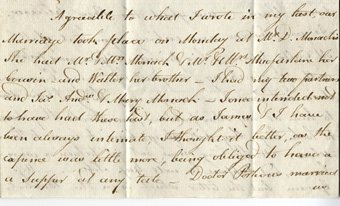This was originally published in April 2011, as part of our Item of the Month series.
With public celebrations for the Royal Wedding of Prince William and Kate Middleton commencing on 29 April, this month we highlight the nuptials of another ‘Kate’ – Catharine MacFarlane (1775-1867), who married Robert Govane (1770-1824) in November 1806.
Catharine was the eldest daughter of George MacFarlane, a farmer from Arduile in the parish of Buchanan, Stirlingshire. Like Kate Middleton, however, marriage would elevate her to the ranks of the socially eminent, for the Govanes were West of Scotland landed gentry, possessing a sizeable estate at Drumquhassle and an impressive family home known as the Park of Drumquhassle. The father of Catharine’s fiancé, Robert Govane senior, had business interests in Glasgow, while his son and heir, Robert junior, was a successful manufacturer there, with interests in the textile industry.
Until the twentieth century, it was usual for members of the propertied classes to have a marriage contract drawn up to ensure the future financial security of their spouse and children. Accordingly, on 13 November 1806, soon after Robert and Kate (as she was affectionately called) became engaged, a contract was prepared by James Cochran, Clerk to John Leckie, lawyer in Glasgow, and witnessed by another Glasgow lawyer, John Knox, and by Duncan Monach, manufacturer. The original document was registered with the courts, but a manuscript copy is preserved among the Govane family papers in the University of Strathclyde Archives and Special Collections.
The contract obliged Robert and Kate to take each other for lawful spouses and to solemnise the marriage at their earliest convenience. In the event of Robert predeceasing Kate, she was to have a free life rent annuity of £25 Sterling per annum, plus £50 Sterling in lieu of household furniture and fittings, while any children born of the marriage would receive one-third of all the heritable and moveable property owned by Robert at the time of his death. For her part, Kate made over to Robert ‘all and sundry lands [,] heritages [,] goods [,] gear [,] debts [,] and sums of money presently belonging or owing to her or which shall become due to her during the subsistence of this Marriage.’ It was clearly stipulated that the contract would remain binding, even if the marriage were to be dissolved within a year and a day of its solemnisation by the death of either party without having produced a living child.
The couple wasted little time in organising their wedding, which took place four days later. In contrast to the scale of arrangements for this month’s Royal Wedding, and in keeping with the customs of the day, Kate MacFarlane’s nuptials were conducted in a discreet and intimate fashion. Writing to his Aunt Barbara on the subject, the groom confessed that ‘I have endeavoured to be at as little expence as possible [,] consi[s]tent with some sort of decency’! The ceremony was held at 5 p.m. on Monday 17 November in the Glasgow home of Mr Duncan Monach, one of the witnesses to the couple’s marriage contract. Besides the minister, Dr William Porteous, only a handful of guests were present: the bride invited her brother, Walter, one of her cousins and his wife, and Mr and Mrs Monach, while the groom’s side comprised his two business partners and the Monachs’ three children, James, Andrew and Mary. After taking a cup of tea, the couple and their guests then repaired to Robert and Kate’s Glasgow house for supper.
Although no likenesses of Kate appear amongst the Govane papers, family correspondence suggests that her physical appearance and demeanour won the approval of her husband’s older relatives – much like the current Royal bride-to-be. In June 1807, for example, Robert’s Aunt Barbara received a letter from her cousin, Agnes, describing a recent meeting with the young Mrs Govane. Favourably impressed, Agnes remarked that Kate ‘is a modest looking Woman, and behaved with great propriety and I make no doubt they [do] well, and perhaps better than if we had made a ma[t]ch for him.’
As well as being a love match, Robert and Kate’s marriage was also a dynastic success. Dispelling any fears that their union might be dissolved within a year and a day by the death of either partner without a living heir, Kate gave birth to her first child, a son named Robert, on 31 August 1807, and went on to have five more children at regular, two-yearly intervals. In 1814 the couple and their children moved back from Glasgow to the Govane family seat, Park of Drumquhassle, to run the estate. Sadly, however, Kate was destined to live longer as a widow than as a wife. After 18 years of marriage, Robert Govane died in 1824. Kate, who consequently became the owner of Park, outlived her husband by over four decades, and died in 1867.
Anne Cameron, Archives Assistant


